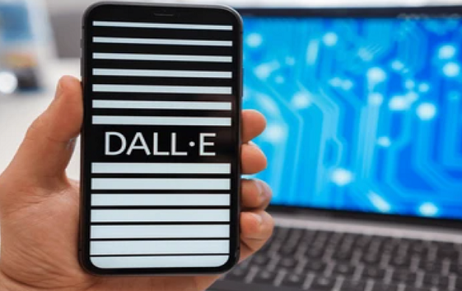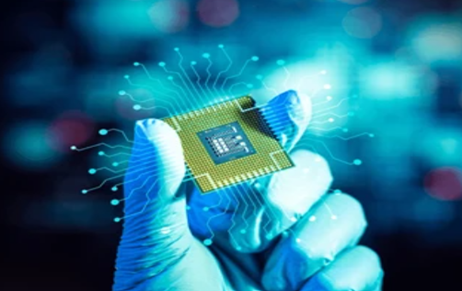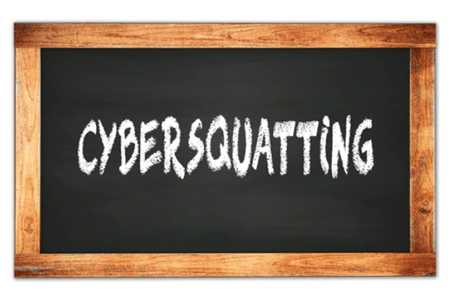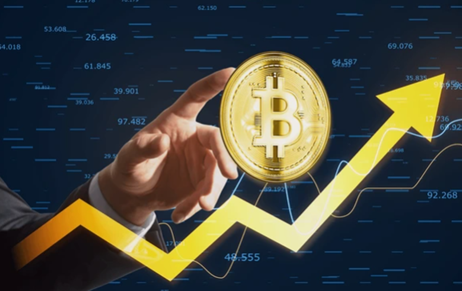Currently, semiconductors act as the foundation for advancements in the technological field such as smartphone…
DALL•E and the Copyright Crossroads: Navigating Originality in AI-Generated Art
Introduction
A breakthrough creation of DALL•E by Open AI, which helps mix visual artistry and language, has resulted in controversy regarding copyright laws. Hence, a pertinent question worth asking is whether the output creation of DALL•E fulfils the originality claims to adhere to the copyright law and whether the copyright protection can be extended to generative artificial intelligence (AI).
This article will delve into this matter by examining the intersection of copyright law and DALL•E, focusing on the legal jurisprudence in India. It would try to deconstruct the creation of AI-generated artistic work and explore the legal ownership right over such creation. This paper will set an academic inquiry into the legality of copyright protection for such products, devoid of human creativity and intelligence.
Beyond the areas mentioned above that the paper will be delving into, this paper will also look into the complex area of rights linked to the creation of DALL•E. It would try to find the rightful owner of such work and the extent of such request, which is paramount for businesses, legal scholars, and artists navigating the realm of AI-driven creation. This paper will also touch upon the matters of copyright infringement by machine learning, creating ambiguity surrounding the areas and posing a threat to the very existence of AI technologies.
Further, the paper will outline the framework illustrating the functionalities of DALL•E and other Generative AI tools. Then, it would focus on the definitional understanding of “originality” by looking at Indian and Global perspectives by drawing established precedents. At last, the paper would contend that Generative AI aligns with the provision of copyright laws, which sets originality principles.
DALL-E-2 and the Copyright Conundrum: Unraveling the Originality Quandary in AI-Generated Art
An intelligent computer program was launched by Open AI on April 2023, called DALL•E. This AI system can create detailed images and realistic artwork based on given descriptions. It mixes different ideas, characteristics and styles with the help of machine learning and GPT-3. DALL•E find a unique and exciting place in today’s world of innovation, where it is recognized as an imposing AI system, resulting in the instant creation of artwork, which traditionally requires human skill and creativity.
Later, the same was upgraded to DALL•E -2, indicating an impressive development in AI. With the help of language understanding and machine learning capabilities of GPT-3, it transforms a written description into a unique visual art by consuming significantly less time. This breakthrough has advanced human abilities to a different level yet challenging human creativity and skill.[i]
The applicability of the images produced by DALL•E-2 is vast, similar to the traditionally made arts. For instance, such images can be used for advertisements, blogs, websites, billboards, etc. However, the main challenge is the copyright protection for such creation by DALL•E-2, prompting a scholarly debate worldwide. This paper will focus on AI and its interaction with copyright laws in India and the rest of the world. DALL•E-2, which is this paper’s primary focus, is the best example. This tool analyses the various data, identifies patterns, and then creates additional content based on that information. With the help of Generative Adversarial Networks, the AI works on self-improvement and indulges across various media formats such as texts, audio, videos and images. Astonishingly, these AI creations are the mimic contents; the same would be copyright protected had it been created by Humans. This paper put forth the unique landscape structured by DALL•E-2, highlighting the intricate relationship between Copyright law and AI, more importantly in the age of machine learning, which is transforming the definition of intellectual property and creative authorship.
[Image Sources: Shutterstock]

Examining the Originality Requirement in Indian Copyright Law and the Implications for Generative AI Systems
In the complex landscape of Indian copyright jurisprudence, the Copyright Act of 1957 became an essential source of copyright law. Section 13 of the act defines the scope of protection for “original literary, musical, dramatic and artistic work.”[ii]This provision has become a fundamental law when we talk about AI systems, such as DALL•E-2, diving into composing music and authoring novels. These Artificial intelligence systems produce their creations with the help of the extensive availability of datasets, posing a question of originality in creating artistic works.
With the growing field of AI law scholarship, the focus has shifted to using neural networks and Artificial intelligence systems like DALL•E-2. These networks collect a vast number of images, information data, videos, and clips, raising concern about the originality of such creations they generate.[iii]AI systems explicitly rely on the pre-existing publicly available data to create new content, unlike traditional authors, who depend on their individual skills and creative efforts. A problem revolving around these AI-generative systems’ infringement of copyright laws has yet to be addressed. The likelihood of such a breach is high as these AI systems rely primarily on billions of data points during training. This becomes a challenge for extending the scope of copyright laws to be more extensive and inclusive, and lastly, requiring AI systems to be legally responsible. The next part of the paper will delve into a comprehensive investigation of the necessity of originality, examining the implications and nuances in the Indian copyright jurisprudence.
Originality Jurisprudence in India
In the global copyright perspective, the definition of originality entails that a work must be independent. The copyright landscape of the United States emphasizes the principle of a “modicum of creativity”. At the same time, the countries that fall under the ordinary law jurisdiction rely on the code of “sweat of the brow”, indicating that a substantial part of labour, even without creativity, would be sufficient to fall under copyright protection. India follows the later principle where some exceptions are provided.
Independence in Indian Copyright Law
In various jurisdictions, an author’s independent creation of work qualifies for protection under copyright laws. In the age of information, the alleged infringer is presumed to be familiar with the result, though the actual connection between the authors is not mandatory.[iv]
Creativity in Indian Copyright Law
In the landmark decision of the Indian Supreme Court in the case of R.G Anansd v Delux Films,[v]the court showed its judicial activism by establishing a pivotal principle in the Indian copyright jurisprudence. It ruled that copyright protection is only available for expressing ideas, not the idea itself. Subsequent judgements such as Gopal Das v Jagganath Prasad and V. Govindan further expanded copyright protection by affirming that even the slightest or modest degree of originality would do such work under the copyright protection.[vi]especially when substantial labour and skill are involved. An interesting case of Burlington Home Shopping, where the court introduced the principle of “sweat of the brow”, which emphasized that with the substantial investment of labour, time and skill, the protection of copyright is extended even to the derivative rights.[vii]However, in the supreme court decisions in India, the court has recognized that the ‘modicum of creativity’ is essential and not just mere labor. In Eastern Book Company vs D.B. Modak’sJudgment, the ruling has marked a significant shift by establishing this doctrine. It stated that the originality of the work must be passed through the coordination, selection, or arrangement of pre-existing information, giving heavy emphasis on judgment and skill apart from mere capital and labour.[viii]
Since we have understood that the ‘modicum of creativity’ doctrine sets a higher threshold by encompassing the “sweat of brow” principle. It becomes pertinent to discuss the originality of creating work by Artificial Intelligence.
The “Modicum of Creativity” Doctrine in US Copyright Law
The doctrine of modicum creative originates in the United States. It revolves around the principle that copyright protection does not extend to facts, formulas and natural discoveries, as explicitly stated in the United States Copyright Act. In the landmark decision of Feist, [ix]the court emphasized that for qualifying for the protection of copyright law, the work must showcase a “sufficient amount of originality”. The court stressed that a mere re-arrangement of information’s that are already available to the public would not be called a creative work and lacks the creative effort by the author.[x]
This doctrine relies on the idea that an author’s work must contain a modest of creativity to qualify for copyright protection. This has a significant impact on shaping the copyright jurisprudence in the world. In the U.S jurisprudence, as long as the work transcends the facts, formulas and natural discoveries, the result would come under the protection of copyright laws.
Copyright Protection for Output Produced by Generative AI: A Critical Examination
The author has discussed the global copyright protection framework relying on the doctrine of originality. This part would emphasize that creating work with the help of DALL–E or any such AI generative system would qualify as original. However, a more pertinent question emerges: does the AI-generated output deserve protection under copyright laws, considering the primary purpose of such protection was to protect and preserve human ingenuity?
This becomes a policy concern. Akin to Microsoft Paint or Photoshop, the work produced by AI generative systems has always been a heated point of discussion for scholars whether it should fall under the protection of copyright or not. Where a traditional way of producing work requires human creativity, Generative AI systems have reshaped the landscape, producing intricate outputs from pre-existing data, images, and videos.[xi]
At the heart of the issue lies a controversy around the original intent of copyright law, which was to protect human ingenuity, i.e., innovation and creativity. This personality concept indicates that the law embodies the will and personality of the creators, which means self-expression through the work.[xii].Interestingly, this is further aligned with the international conventions such as the Berne Convention and legislations of some countries such as the U.S., Spain and Germany, which believe that copyright protection is available only for humans.
In contrast, the Indian jurisprudence lacks clarity on the scope of copyright protection produced by Generative Artificial Intelligence and posits an imperative question of authorship in a controversial position in the realm of Intellectual Property Rights. Section 2(d)(vi) of the Copyright Act of 1957 suggests a more inclusive definition; however, judicial decisions such as Rupendra Kashyap v. Jiwan Publishing House Ltd, where the court re-emphasized the requirement of involvement of humans to avail the benefits of copyright protection.[xiii][xiv]
Various interpretations and emphases have been laid by scholars arguing for and against the extension of copyright protection of the work created by AI generative systems by entering prompts. A novel proposition in favour of it suggests granting protection under copyright to humans with a very distinctive and unique prompt would be enough to demonstrate “creativity”.[xv]
Regardless of the decisions that might come in future, the common law jurisprudence adhered to the doctrine of “sweat of the brow” of the Lockean concept and may lean towards denying protection under the copyright law. The theory of Lock emphasized the human endeavor resulting in a reward for such work of creative process- which goes against the very concept of the creation of work generated by artificial intelligence where no human endeavor is involved.[xvi]
In addition, AI or computer-generated work might not be based on economic incentives as has been embedded in the copyright laws; that is one of the reasons that human endeavors require such protection. It could be a good argument that such creation should not be necessary as a defense. Even without copyright protection, the use and output of AI wouldn’t likely diminish doctrinally.[xvii]
Assuming authorship is affirmed, the next question arises: is the output produced by Generative AI copyrightable?
On the Question of Independence
When we talk about the problem surrounding the independent creative effort in the realm of copyright law, the burden to prove that the work is independent is on the defendant if he/she/they were unfamiliar with the plaintiff’s work or were without the knowledge of such pre-existing work. While it is straightforward to locate the artists who created their work in traditional creation, artificial intelligence creates many problems regarding their trustworthy source of innovation.
In the artificial generative system, the user command through refined prompts with the help of various iterations is emphasized as a creative exercise to generate artistic work. At the same time, the AI system reduces human efforts when we compare it with traditional ways of creative work. However, even the AI generative system involves human effort. The only difference is the nature of tools but not the fundamental change in creative production itself. The protection under the copyright laws can be justified for such creation by AI, meeting the principle of originality and creativity together.
On the Question of Creativity
While applying the “modicum of creativity” test to the output produced by AI generative tools, it is pertinent to ask two questions: Does the test apply to the final result or the prompt, and does it matter whether the user knew the outcome?
The judicial precedent that is available in this regard, i.e., the judgment in the Feist case, where the court emphasized that the test would primarily apply to the output of the AI generative system and not the prompts. Based on this, DALL–E’s production meets the examination of the “modicum of creativity” threshold, as it generates the outputs by a unique selection process and arrangement of pre-existing information.
Further, the lack of anticipation of the outcome of the AI generative system does not undermine the copyrightability. The law surrounding copyright is rooted in advancing a unique and beneficial culture in society and doesn’t evaluate the outcome based on expectations. Although the users don’t have control over the final output in the AI generative systems, the protection under the copyright laws remains applicable to premeditated, unexpected or even erroneous results.
Conclusion
The emergence of DALL•E and its successor, DALL•E-2, gave birth to an intricate debate at the crossroads of copyright law and AI-generated work. On the voyage of this journey, where the paper has focused on the nuance of the originality argument to bring work under copyright protection, the author has tried to deconstruct the legal controversy surrounding the same from a global and domestic perspective. These debates revolve around the protection of human integrity. While the problem persists around the definition of authorship and creativity in the works generated by AI-generative systems, this paper has tried to underscore the requirement of legal adaptation in the era of machine learning. To provide equitable protection in an ever-growing digital world, there is a balance between preserving creative rights and innovation.
Author: Shivam Sharma, in case of any queries please contact/write back to us via email to chhavi@khuranaandkhurana.com or at IIPRD.
[i]OpenAI, DALL-E-2, available at https://openai.com/dall-e-2/
[ii]The Copyright Act, 1957, §13.
[iii] Martin Anderson, The Future of AI, available at https://rossdawson.com/futurist/implications-of-ai/future-of-ai-image-synthesis/
[iv]Fenwick, Mark and Jurcys, Paulius, Originality and the Future of Copyright in an Age of Generative AI
[v] R.G. Anand v. Deluxe Films, (1978) 4 SCC 188.
[vi] Gopal Das v. Jagganath Prasad, AIR 1938 AII 266.
[vii] Burlington Home Shopping Ltd. v. Rajnish Chibber, 1995 SCC OnLine Del 746.
[viii] Eastern Book Company v. D.B. Modak, AIR 2008 SC 809.
[ix] Feist Publications, Inc v Rural Telephone Service Company, Inc, 499 US 340 (1991) 345.
[x] Reckeweg v. Adven Biotech, (2008) 38 PTC 308.
[xi]Lemley, Mark A., How Generative Ai Turns Copyright Law on its Head). Available at SSRN: https://ssrn.com/abstract=4517702
[xii] Haochen Sun, Redesigning Copyright Protection in the Era of Artificial Intelligence, 107 Iowa L. Rev. 1213 (2022)
[xiii] Rupendra Kashyap v. Jiwan Publishing House, 1996 SCC OnLine Del 466.
[xiv] Tech Plus Media Pvt. Ltd. v. Jyoti Janda, 2014 SCC OnLine 1456.
[xv]Lemley, Mark A., How Generative Ai Turns Copyright Law on its Head (July 21, 2023). Available at SSRN: https://ssrn.com/abstract=4517702
[xvi]Chatterjee, Mala, Intellectual Property, Independent Creation, and the Lockean Commons. 12 UC Irvine Law Review 747 (2022).
[xvii] Pamela Samuelson, Allocating Ownership in Computer-Generated Works, 47 U. Pitt. L. Rev. 1185, 1199, 1192 (1986)



